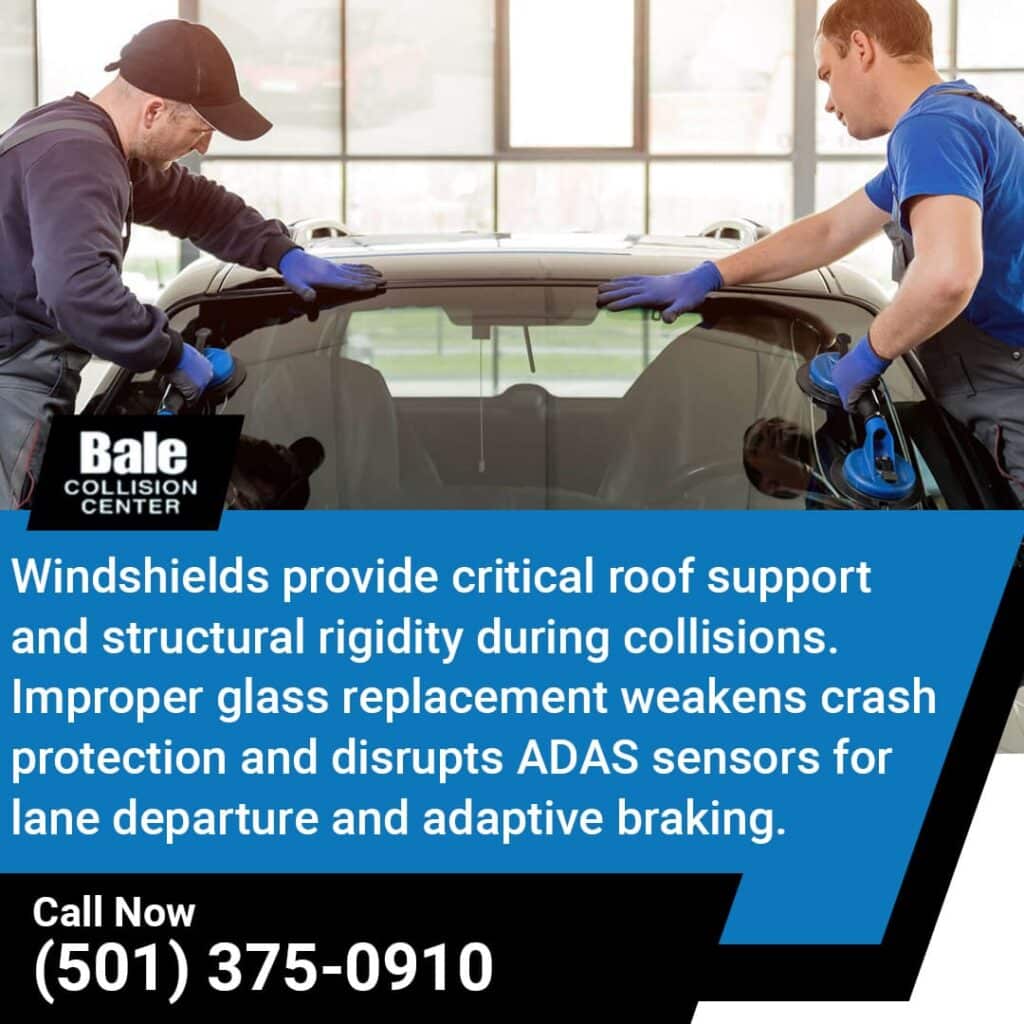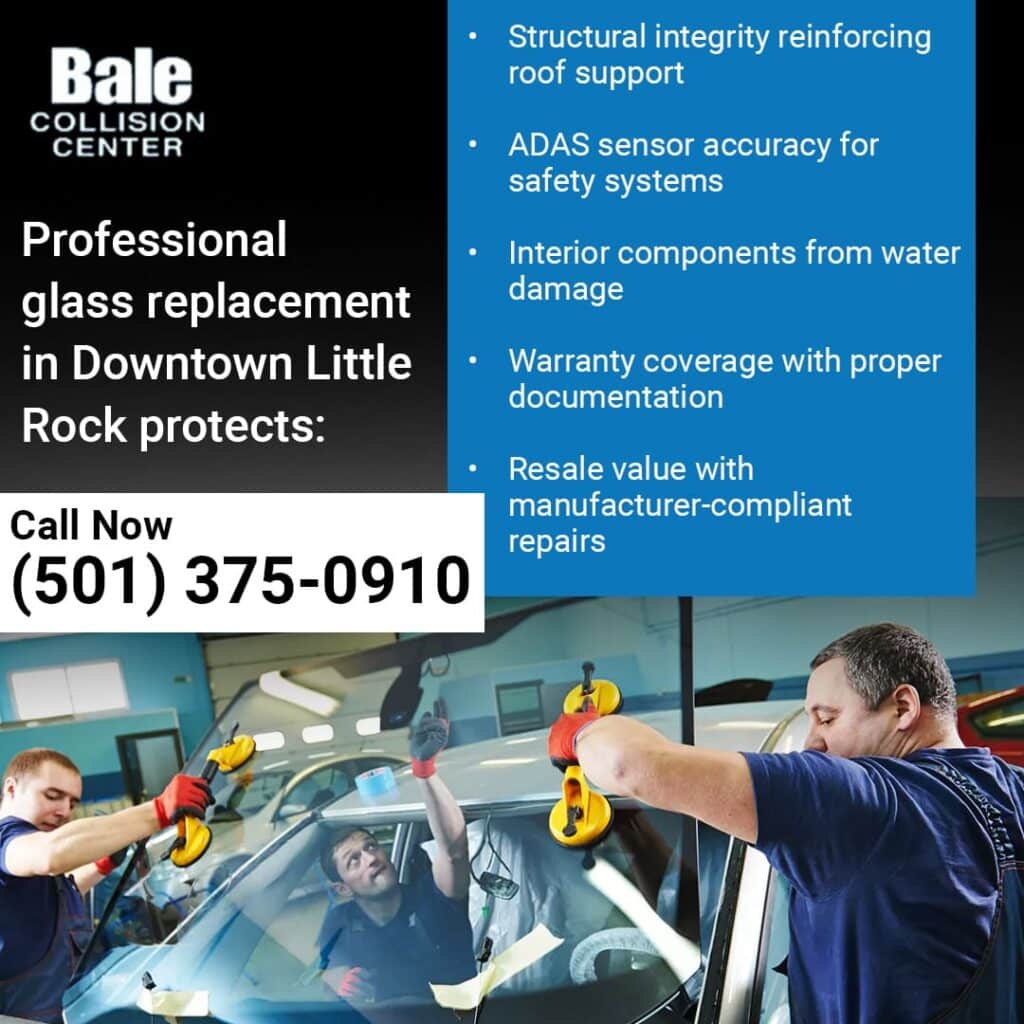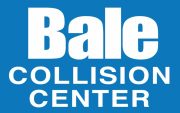After a collision, many vehicle owners focus on visible body damage while overlooking broken or cracked glass. The reality is that automotive glass is more than a cosmetic feature. It plays a critical role in protecting the driver, passengers, and the structural integrity of the vehicle. A damaged windshield or side window can compromise airbag function, weaken roof support in a rollover, and reduce visibility in everyday driving. These risks make timely and proper glass replacement an essential part of collision repair, not an optional service.
At Bale Collision Center (Downtown) in Little Rock, AR, we address these concerns with a repair process that treats glass as a vital safety component. By combining precise installation, manufacturer-approved procedures, and advanced diagnostic tools, our team restores the security and reliability that drivers expect from their vehicles. For customers balancing insurance requirements, safety concerns, and long-term vehicle value, proper glass replacement is one of the most important steps in complete vehicle collision repair.

Glass as Part of the Vehicle’s Safety System
The Hidden Strength of Windshields
Direct Function:
The windshield is a key structural component, not merely a window. It reinforces the roof and helps maintain the vehicle’s overall rigidity. In rollover collisions, a strong windshield supports the roof, reducing the risk of collapse and protecting occupants.
Force Distribution:
Windshields are designed to absorb and distribute impact forces across the cabin. Even a minor crack or chip weakens this ability, decreasing the vehicle’s structural integrity and compromising occupant protection.
Safety Integration:
Beyond roof support, the windshield maintains alignment of other body components, such as doors and pillars. This alignment ensures that safety systems, like airbags and seatbelt mechanisms, function as intended. Maintaining windshield integrity is, therefore, a critical element in professional collision repair, ensuring safety is restored to factory specifications.
How Glass Works With Other Safety Features
System Interdependence:
Automotive glass is integral to the performance of airbags, crumple zones, and seatbelt systems. When glass is installed correctly, these safety systems can deploy and absorb forces as designed.
Impact of Damage or Poor Installation:
Damaged or improperly fitted glass reduces the effectiveness of these systems. For example, an airbag depends on a secure windshield to deploy toward passengers, rather than dispersing outward ineffectively. Similarly, crumple zones and seatbelt pre-tensioners rely on stable glass panels to help absorb and redirect impact energy during a collision.
Repair Importance:
Ensuring the correct installation and structural integrity of all glass components is essential for restoring full safety during vehicle collision repair. Neglecting this aspect can compromise both occupant protection and overall vehicle performance after a crash.
Risks of Ignoring Glass Damage After a Collision
Compromised Visibility in Everyday Driving
Cracks, chips, or distortions in automotive glass can reduce visibility and increase driving risk. Even minor fractures create glare, distort vision, or form blind spots that make it difficult to judge distance, read road signs, or identify pedestrians and other vehicles. Over time, small chips can spread, further compromising clarity and driver confidence.
According to the AAA and other traffic safety organizations, driving with a cracked windshield increases your risk of reduced visibility and makes collisions more likely. Clear, intact glass is essential for safe vehicle operation and is a critical part of professional auto collision repair in Downtown Little Rock, AR.
Water Intrusion and Interior Damage
Damaged glass can allow water to enter the vehicle, leading to interior damage and higher long-term repair costs. Even minor leaks around a windshield, side window, or rear glass can seep into upholstery, carpets, and electrical systems. Persistent moisture promotes mold growth, corrosion of metal components, and potential failure of vehicle sensors or lighting circuits.
Water intrusion also accelerates wear on interior panels, electronic modules, and insulation. Prompt attention to glass damage as part of vehicle collision repair protects interior integrity and helps prevent costly long-term maintenance issues.
Structural Weakness During Future Impacts
Even small fractures compromise the structural integrity of the vehicle in subsequent collisions. Glass contributes to roof support, side-impact protection, and correct airbag deployment. A weakened windshield or window may fail to properly absorb or distribute forces during a crash.
Vehicles with compromised windshields absorb less crash energy in rollover events. Replacing damaged glass promptly keeps structural support and occupant protection aligned with manufacturer safety standards.
Technology and Glass Replacement
Role of Sensors and Cameras
Modern vehicles integrate sensors and cameras directly into automotive glass to support safety systems. Advanced Driver Assistance Systems (ADAS) rely on windshield-mounted cameras, rain sensors, and lane departure sensors to function accurately. These systems control automatic braking, lane keeping assistance, adaptive cruise control, and collision warnings.
Proper operation of ADAS requires intact and correctly positioned glass. Misaligned or damaged windshields can obstruct sensors, resulting in delayed alerts or system malfunctions. Automotive safety experts emphasize that miscalibrated ADAS components can reduce the effectiveness of vital safety features. This highlights the critical link between glass condition and overall vehicle safety.
The Importance of Precision Installation
Precision installation of replacement glass keeps sensors and cameras accurately calibrated. Even small gaps, uneven adhesion, or tilted glass can interfere with sensor alignment, causing inaccurate readings or false alerts. This affects driver safety, reduces system reliability, and may lead to further mechanical or electronic issues.
Certified auto collision centers use digital measuring tools and factory-approved procedures to maintain exact windshield placement. Accurate installation preserves ADAS performance, supports collision repair standards, and maintains compliance with manufacturer specifications.
Quality Standards and Inspection in Glass Replacement
Importance of Post-Replacement Inspections
After a collision, verifying that glass replacement meets professional standards is critical to long-term safety and vehicle performance. Quality inspections make sure that the windshield, side windows, and rear glass are properly aligned, fully sealed, and correctly bonded to the frame. Proper bonding maintains structural integrity, supports roof strength during rollovers, and prevents future leaks or water intrusion. Even small misalignments or gaps can weaken the glass’s ability to absorb impact forces, which is why precise verification is an essential part of auto collision repair.
Ensuring Safety System Accuracy
Certified inspection procedures also confirm that Advanced Driver Assistance Systems (ADAS) sensors and cameras mounted on the glass are functioning accurately. A thorough post-installation inspection addresses the concerns, ensuring that safety systems work as intended and that driver alerts remain accurate.
Reducing Long-Term Risks
By including quality inspections as part of the glass replacement workflow, vehicle owners can reduce the likelihood of long-term issues such as leaks, sensor malfunctions, or weakened roof support. These procedures complement the precision installation process and ensure that the glass functions as an active component of the vehicle’s safety system. Having a certified, thorough inspection integrated into the collision repair process ensures both safety and reliability after every repair.
Insurance and Documentation Benefits
Why Insurers Treat Glass as a Safety Priority
Insurance providers consider damaged automotive glass a safety risk due to its role in structural integrity and sensor function. Insurance companies give priority to proper glass replacement to lower injury risk and maintain vehicle safety standards. Timely repairs also help avoid claims disputes if subsequent damage occurs.
Most vehicle collision repair claims for glass are covered under comprehensive or collision insurance, depending on the cause of damage. Proper documentation and certified repairs support smooth claim processing and prevent delays or denials.
Certified Records That Protect Vehicle Value
Documented glass repairs maintain the vehicle’s resale value and warranty coverage. Repair records show that replacement glass met manufacturer specifications and included precise recalibration of ADAS systems. Without verified documentation, future buyers or dealerships may question the integrity of the vehicle, potentially reducing resale or trade-in value.
Reliable auto collision centers issue detailed records that include parts used, installation procedures, and calibration reports. These records also help maintain factory warranties and validate insurance-approved collision repair, ensuring the vehicle remains safe and compliant over time.

Bale Collision Center: Expert Auto Glass Replacement in Little Rock
Why Expertise Matters for Glass Replacement
Professional glass replacement is critical for both safety and vehicle performance. Unlike simple auto glass repair shops, full collision repair centers address the structural role of glass, ensuring correct alignment, roof support, and proper integration with safety systems. Improper installation can compromise airbags, seatbelts, and ADAS functions, increasing risk during future collisions.
At Bale Collision Center, we apply precision methods to restore vehicles after any collision. This includes thorough inspection, structural assessment, and calibrated installation to meet manufacturer standards, which is essential for maintaining the vehicle’s crashworthiness and safety systems.
Certified Team and Insurance-Approved Repairs
Certified technicians handle glass replacement as part of the collision repair process. At Bale Collision Center, we have I-CAR Platinum-certified professionals who follow OEM repair procedures for every vehicle. These methods make sure that windshields, side windows, and other critical glass components are correctly fitted and recalibrated for ADAS sensors when required.
Insurance-approved collision repairs guarantee that all procedures meet carrier requirements and protect both warranty coverage and resale value. Documented repair records provide proof of proper installation, supporting future claims and preserving the integrity of auto collision repair in Downtown Little Rock, AR.
Reliable Auto Collision Center in Downtown Little Rock, AR for Glass and Body Repairs
Glass replacement is essential for maintaining vehicle safety and long-term value. Properly installed and calibrated glass supports structural integrity, maintains the correct functioning of safety systems, and prevents interior damage or visibility issues after a collision. Bale Collision Center provides expert auto collision repair in Downtown Little Rock, AR, which includes precision glass replacement, using certified technicians and OEM procedures. Their repair approach restores vehicles safely, protecting both drivers and the long-term value of the vehicle.
For expert glass replacement and complete collision repair in Downtown Little Rock, contact Bale Collision Center today at (501) 375-0910 or bccdowntown@baleautomotive.com.
